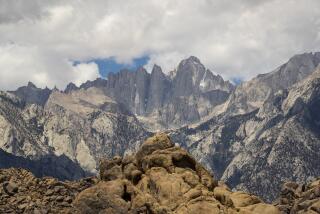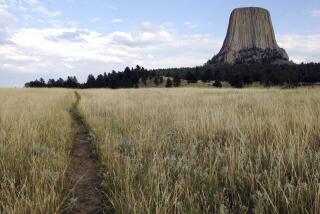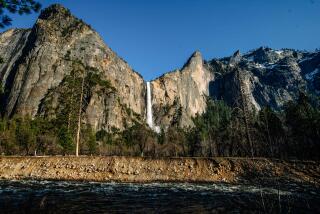Climber plunges to death in Yosemite
Todd Skinner, a leading American rock climber who gained international fame for a pioneering 1988 ascent in Yosemite National Park, was killed in an accidental fall while on another Yosemite outing this week, park officials said Tuesday.
Skinner, 47, plummeted at least 500 feet about 4 p.m. Monday while rappelling down the Leaning Tower monolith near Bridalveil Fall in the Yosemite Valley. A park spokesman, Scott Gediman, said rangers arrived within 10 minutes after being called by Skinner’s climbing partner, Jim Hewett. They pronounced Skinner dead at the scene.
Park officials still are investigating the cause. However, a family spokesman, Steve Bechtel, said authorities had told him that their preliminary finding was that Skinner’s climbing harness broke.
Skinner was a leading free climber -- meaning he relied on his hands, feet and other parts of the body to ascend cliffs, and used equipment only for protection against a fall. On his website, www.toddskinner.com, he said he had achieved more than 300 successful first ascents in 26 countries.
He is best known as being the first to make a free ascent, along with partner Paul Piana, of the Salathe Wall of El Capitan, a forbidding granite formation in Yosemite National Park. That 1988 accomplishment also was one of the most harrowing moments in his career. He and Piana were anchored by a rope to a huge boulder at El Capitan’s peak when the giant rock began to roll over them.
As he and Piana recounted the story to Life magazine in 1994, the boulder crashed down to the Yosemite Valley floor, more than 3,000 feet below. The two climbers would have been pulled down too if the rock hadn’t luckily cut the safety rope, while leaving a backup line intact.
Piana had a smashed foot and a leg broken in five places, and Skinner suffered broken ribs, but despite being hampered by their painful injuries, they managed to climb down.
“We learned the hard way that the adventure isn’t over when you reach the top,” Skinner told the magazine.
In 1995, he gained further acclaim for a pioneering climb of Nameless Tower, also known as Trango Tower, in the Himalayan Mountains in Pakistan.
That year, in an interview with the Denver Post, Skinner was quoted as saying there are three types of fear in rock climbing: “What you have been afraid of, what are you afraid of now, and what you will be afraid of. The last one is the worst. It is the part of the climb that you cannot fight with right now, and for some climbers, the specter of it above their heads is too much for them,” he said.
He also said, in the same interview, that rock climbers in some cases are motivated by competition, “but in the big ranges, on the big walls, it is not the driving force. There is nobody up there to compete with except yourself.”
Skinner was born and raised in Wyoming and had lived for 16 years in Lander, Wyo. His wife, Amy, is an amateur climber, and they have three young children, ranging in age from 5 to 7.
Skinner’s death follows the recent fatal accident of another outdoor adventurer. Brian Schubert, who inspired the extreme sport of base jumping when he and a friend strapped parachutes to their backs and leaped off the El Capitan cliff in 1966, died Saturday on his first jump in 40 years. Schubert, a former Pomona police officer, was killed when his parachute opened too late after he jumped off an 876-foot bridge into the New River Gorge in Fayetteville, W.Va.
*
stuart.silverstein@latimes.com
More to Read
Sign up for The Wild
We’ll help you find the best places to hike, bike and run, as well as the perfect silent spots for meditation and yoga.
You may occasionally receive promotional content from the Los Angeles Times.






